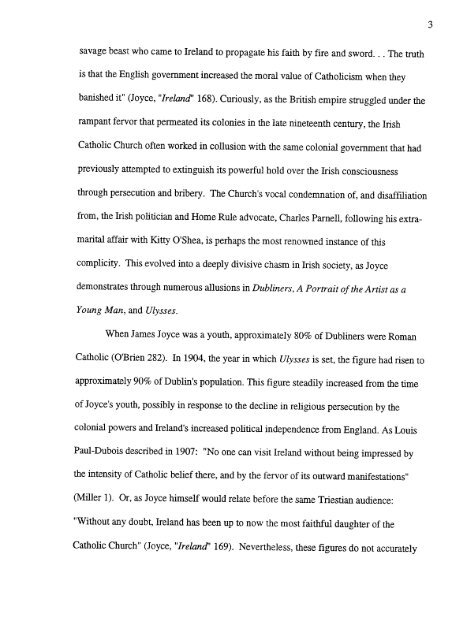Faubourg Saint Patrice - ScholarsArchive at Oregon State University
Faubourg Saint Patrice - ScholarsArchive at Oregon State University
Faubourg Saint Patrice - ScholarsArchive at Oregon State University
You also want an ePaper? Increase the reach of your titles
YUMPU automatically turns print PDFs into web optimized ePapers that Google loves.
savage beast who came to Ireland to propag<strong>at</strong>e his faith by fire and sword. . . The truth<br />
is th<strong>at</strong> the English government increased the moral value of C<strong>at</strong>holicism when they<br />
banished it" (Joyce, "Ireland" 168). Curiously, as the British empire struggled under the<br />
rampant fervor th<strong>at</strong> perme<strong>at</strong>ed its colonies in the l<strong>at</strong>e nineteenth century, the Irish<br />
C<strong>at</strong>holic Church often worked in collusion with the same colonial government th<strong>at</strong> had<br />
previously <strong>at</strong>tempted to extinguish its powerful hold over the Irish consciousness<br />
through persecution and bribery. The Church's vocal condemn<strong>at</strong>ion of, and disaffili<strong>at</strong>ion<br />
from, the Irish politician and Home Rule advoc<strong>at</strong>e, Charles Parnell, following his extra<br />
marital affair with Kitty O'Shea, is perhaps the most renowned instance of this<br />
complicity. This evolved into a deeply divisive chasm in Irish society, as Joyce<br />
demonstr<strong>at</strong>es through numerous allusions in Dubliners, A Portrait of the Artist as a<br />
Young Man, and Ulysses.<br />
When James Joyce was a youth, approxim<strong>at</strong>ely 80% of Dubliners were Roman<br />
C<strong>at</strong>holic (O'Brien 282). In 1904, the year in which Ulysses is set, the figure had risen to<br />
approxim<strong>at</strong>ely 90% of Dublin's popul<strong>at</strong>ion. This figure steadily increased from the time<br />
of Joyce's youth, possibly in response to the decline in religious persecution by the<br />
colonial powers and Ireland's increased political independence from England. As Louis<br />
Paul-Dubois described in 1907: "No one can visit Ireland without being impressed by<br />
the intensity of C<strong>at</strong>holic belief there, and by the fervor of its outward manifest<strong>at</strong>ions"<br />
(Miller 1). Or, as Joyce himself would rel<strong>at</strong>e before the same Triestian audience:<br />
"Without any doubt, Ireland has been up to now the most faithful daughter of the<br />
C<strong>at</strong>holic Church" (Joyce, "Ireland" 169). Nevertheless, these figures do not accur<strong>at</strong>ely<br />
3















